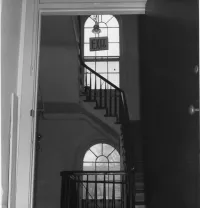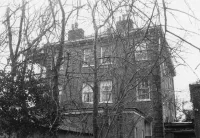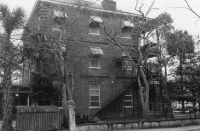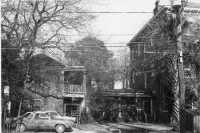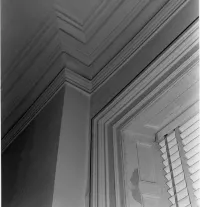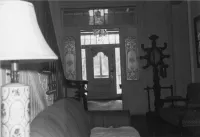Share what you know,
and discover more.
Share what you know,
and discover more.
Apr 04, 2014
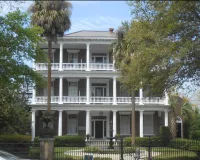
William Robb House
The William Robb House is a mid 19th-century house in Charleston, South Carolina situated at No.12 (formerly No.4) Bee Street.
Apr 04, 2014
William Robb House
The William Robb House is a mid 19th-century house in Charleston, South Carolina situated at No.12 (formerly No.4) Bee Street.Posted Date
Oct 14, 2022
Historical Record Date
Apr 04, 2014
Source Name
Wikipedia
Source Website
Delete Story
Are you sure you want to delete this story?
Sep 08, 1983
Sep 08, 1983
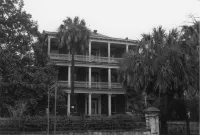
-

- Charmaine Bantugan
National Register of Historic Places - William Robb House
Statement of Significant: The William Robb House is located in the Cannons borough section of Charleston South Carolina. The residence is significant for its association with William Robb, partner in the East Point Rice Mill, and with philanthropist William King McDowell. The house, as built by Robb ca. 1858, embodies classical revival stylistic elements. The remodeling of the interior of the house dates from ca. 1920 and reveals the important twentieth century adaptation of the house by McDowell for use as Mercy Maternity Hospital and, after 1929 the Episcopal Church Home for Women. Whereas the William, Robb House reflected the prosperity of the nineteenth century South Carolina Tice industry, it later became a local symbol of reform ideals which drew on the legacy of the progressive movement. Additional Information From its introduction to South Carolina in the seventeenth century through the nineteenth century, the cultivation and production of rice played an important role in the state's economic, political and cultural development. As rice planting increased through the nineteenth century so too did the commercial rice milling industry. In the nineteenth century Charleston became the center of the rice milling industry in South Carolina. l by 1849 South Carolina produced over 70 percent of the nation's rice or 1.5 million pounds. This large and Lucrative rice trade attracted many investors including James Robb, a merchant, and James McLaren, an engineer. A contemporary diary noted on January 24, 1846, that "'Mr. McLaren has bought Napier’s old mill and is going to establish a Rice Mill-it is said Jas. Robb is, concerned.'" The 1883 Charleston City Yearbook further stated that Robb and McLaren "about 1846 erected thereon an improved steam rice mill, and conducted there a large and profitable business." The mill was located on the Cooper River on Gadsden's Wharf and was known as the East Point Mill. By 1849 James Robb's son, William, was employed at the mill as a clerk. James Robb died in 1859 and by that time his two sons, William and James Robb, Jr., had become the joint owners of the East Point Mill. The area of Charleston known as Cannons borough was a center for the rice milling industry in South Carolina; in addition to the Cannons borough and West Point mills, it included the substantial homes of two wealthy millers, Jonathan Lucas and Governor Thomas Bennett. It was in Cannons borough, on Bee Street, that William Robb bought the land for his house from Thomas Condy in March 1858 for $5,200. Robb built his house shortly afterwards, for the 1860 Census listed William Robb on Bee Street-with his Scottish wife, two children and two female Irish maids. The census further reveals that Robb owned real estate worth $18,000. The house as built by Robb certainly attests to the "large and profitable business" begun at the East Point Mill. The 1861 Census for the City of, Charleston shows that the William Robb House was the only brick building on Bee Street.
National Register of Historic Places - William Robb House
Statement of Significant: The William Robb House is located in the Cannons borough section of Charleston South Carolina. The residence is significant for its association with William Robb, partner in the East Point Rice Mill, and with philanthropist William King McDowell. The house, as built by Robb ca. 1858, embodies classical revival stylistic elements. The remodeling of the interior of the house dates from ca. 1920 and reveals the important twentieth century adaptation of the house by McDowell for use as Mercy Maternity Hospital and, after 1929 the Episcopal Church Home for Women. Whereas the William, Robb House reflected the prosperity of the nineteenth century South Carolina Tice industry, it later became a local symbol of reform ideals which drew on the legacy of the progressive movement. Additional Information From its introduction to South Carolina in the seventeenth century through the nineteenth century, the cultivation and production of rice played an important role in the state's economic, political and cultural development. As rice planting increased through the nineteenth century so too did the commercial rice milling industry. In the nineteenth century Charleston became the center of the rice milling industry in South Carolina. l by 1849 South Carolina produced over 70 percent of the nation's rice or 1.5 million pounds. This large and Lucrative rice trade attracted many investors including James Robb, a merchant, and James McLaren, an engineer. A contemporary diary noted on January 24, 1846, that "'Mr. McLaren has bought Napier’s old mill and is going to establish a Rice Mill-it is said Jas. Robb is, concerned.'" The 1883 Charleston City Yearbook further stated that Robb and McLaren "about 1846 erected thereon an improved steam rice mill, and conducted there a large and profitable business." The mill was located on the Cooper River on Gadsden's Wharf and was known as the East Point Mill. By 1849 James Robb's son, William, was employed at the mill as a clerk. James Robb died in 1859 and by that time his two sons, William and James Robb, Jr., had become the joint owners of the East Point Mill. The area of Charleston known as Cannons borough was a center for the rice milling industry in South Carolina; in addition to the Cannons borough and West Point mills, it included the substantial homes of two wealthy millers, Jonathan Lucas and Governor Thomas Bennett. It was in Cannons borough, on Bee Street, that William Robb bought the land for his house from Thomas Condy in March 1858 for $5,200. Robb built his house shortly afterwards, for the 1860 Census listed William Robb on Bee Street-with his Scottish wife, two children and two female Irish maids. The census further reveals that Robb owned real estate worth $18,000. The house as built by Robb certainly attests to the "large and profitable business" begun at the East Point Mill. The 1861 Census for the City of, Charleston shows that the William Robb House was the only brick building on Bee Street.
National Register of Historic Places - William Robb House
Statement of Significant:The William Robb House is located in the Cannons borough section of Charleston South Carolina. The residence is significant for its association with William Robb, partner in the East Point Rice Mill, and with philanthropist William King McDowell. The house, as built by Robb ca. 1858, embodies classical revival stylistic elements. The remodeling of the interior of the house dates from ca. 1920 and reveals the important twentieth century adaptation of the house by McDowell for use as Mercy Maternity Hospital and, after 1929 the Episcopal Church Home for Women. Whereas the William, Robb House reflected the prosperity of the nineteenth century South Carolina Tice industry, it later became a local symbol of reform ideals which drew on the legacy of the progressive movement.
Additional Information
From its introduction to South Carolina in the seventeenth century through the nineteenth century, the cultivation and production of rice played an important role in the state's economic, political and cultural development. As rice planting increased through the nineteenth century so too did the commercial rice milling industry.
In the nineteenth century Charleston became the center of the rice milling industry in South Carolina. l by 1849 South Carolina produced over 70 percent of the nation's rice or 1.5 million pounds. This large and Lucrative rice trade attracted many investors including James Robb, a merchant, and James McLaren, an engineer.
A contemporary diary noted on January 24, 1846, that "'Mr. McLaren has bought Napier’s old mill and is going to establish a Rice Mill-it is said Jas. Robb is, concerned.'"
The 1883 Charleston City Yearbook further stated that Robb and McLaren "about 1846 erected thereon an improved steam rice mill, and conducted there a large and profitable business." The mill was located on the Cooper River on Gadsden's Wharf and was known as the East Point Mill. By 1849 James Robb's son, William, was employed at the mill as a clerk. James Robb died in 1859 and by that time his two sons, William and James Robb, Jr., had become the joint owners of the East Point Mill.
The area of Charleston known as Cannons borough was a center for the rice milling industry in South Carolina; in addition to the Cannons borough and West Point mills, it included the substantial homes of two wealthy millers, Jonathan Lucas and Governor Thomas Bennett.
It was in Cannons borough, on Bee Street, that William Robb bought the land for his house from Thomas Condy in March 1858 for $5,200. Robb built his house shortly afterwards, for the 1860 Census listed William Robb on Bee Street-with his Scottish wife, two children and two female Irish maids. The census further reveals that Robb owned real estate worth $18,000. The house as built by Robb certainly attests to the "large and profitable business" begun at the East Point Mill. The 1861 Census for the City of, Charleston shows that the William Robb House was the only brick building on Bee Street.
Posted Date
Jun 12, 2023
Historical Record Date
Sep 08, 1983
Source Name
National Register of Historic Places
Source Website
Delete Story
Are you sure you want to delete this story?


